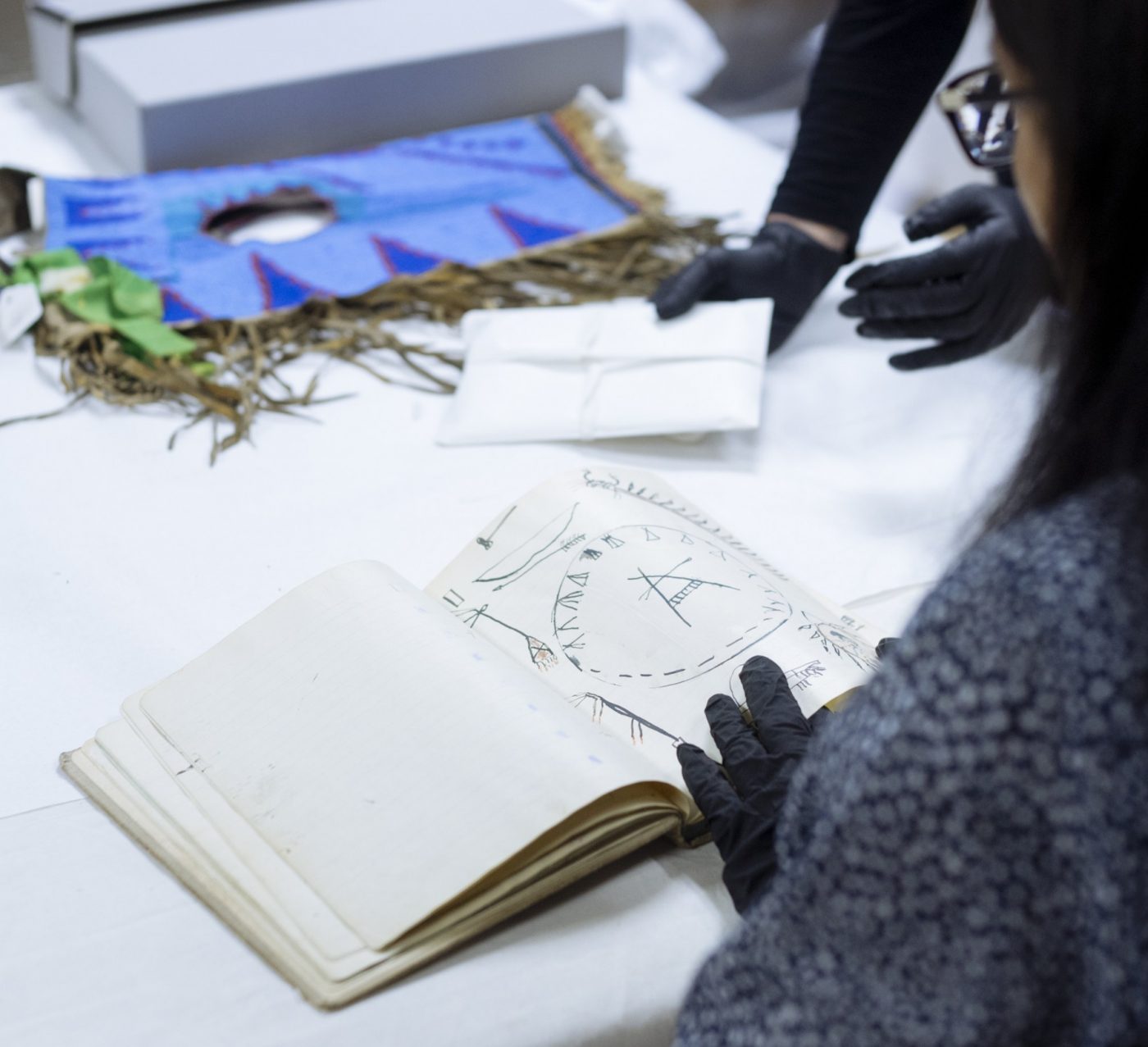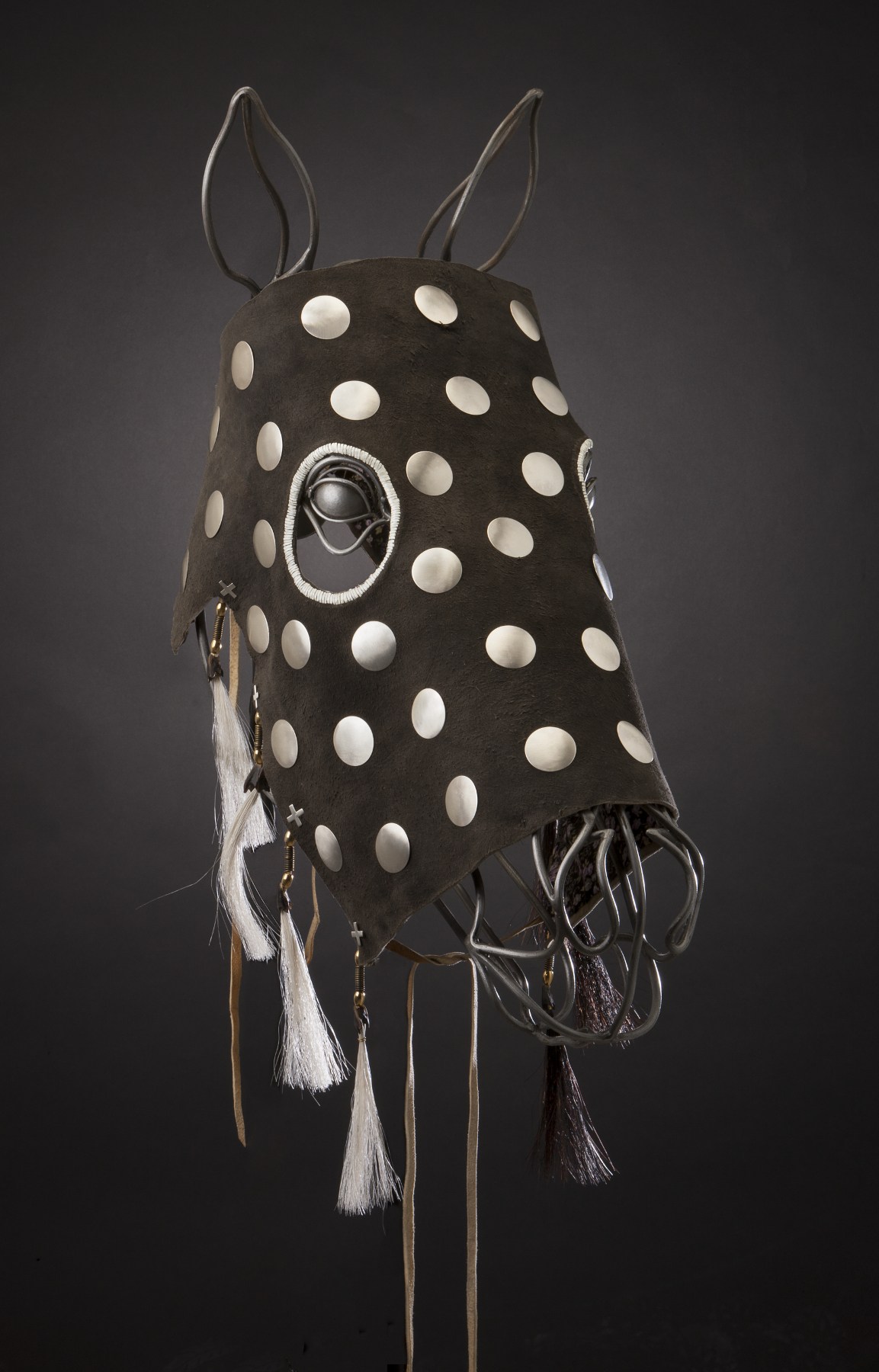Connectivity is at the heart of Albertine Crow Shoe’s practice as an artist. Drawing on her family history, her culture and even her dreams, Crow Shoe incorporates traditional symbolism, designs and material into her work her as jeweller, blending it all with new materials and her own unique vision. This approach made Crow Shoe, a member of the Piikani Nation, an ideal participant for Glenbow’s Artist in Residence program, in which an artist is invited to research an area of the collection and create new work based on their findings.
During her time as Artist in Residence throughout 2018, Crow Shoe found inspiration in traditional Blackfoot motifs, including floral designs and quillwork, as well as Haida and Inuit materials.
In the resulting exhibition, Sik sika tsi ta pi sini / Sa kaiss skoo na tapiwa / Kii pait ta pii sin noon (The Blackfoot People’s Way of Life is Still Strong), Crow Shoe’s art works are displayed alongside the objects by which they were inspired.
Crow Shoe recently spoke to us about her process, practice and her exhibition.
You’ve said that your ability to create came from your mother. How so? Was she an artistic person?
For as long as I can remember, my mom was always busy. I have a large family – seven sisters and three brothers (one has passed) – so there were always little ones. When she wasn’t cleaning or taking care of us… she was sewing, making things or beading. She had this old Singer pedal machine. I remember sitting there as a little girl and she made clothes for this little stuffed animal that I had. She was always doing something with her hands.
So did you start off at a young age?
It’s funny, I remember this: my sister sitting with my brother and one of my younger sisters and she had them drawing, and I wasn’t part of it. That image always comes up whenever I think of myself as an artist. But I liked to draw, nothing fancy, sew and do things with my hands. Later on, I learned to bead and make crafts – looking at different ways of creating.
Your great grandfather’s winter count ledger is part of the Glenbow collection and is included as part of your exhibition. You also mention his influence, specifically the pictographs in his ledger – when did you first learn about it?
My father spoke very little about it. It wasn’t until maybe my twenties that I started to learn more about who [my great grandfather] was and that he had this winter count.

Were you specifically influenced by the style of illustration – pictographs – in the ledger?
The symbolism, yes. They hold so much meaning. What I found really significant, is that when we signed the Treaty you see those “men figures.” You see them in different places – you see them on story robes, the winter count, on tipis. They bring connection and tell a story.
And a big part of your practice is making connections…
It is. My goal is to teach through my work. My hope is that people walk away from this exhibit learning something they didn’t know – then I’d be happy.
How did you get into jewellery making?
I took my first class in 2007, from ACAD, before they turned into a university. They had a continuing education class, evenings and weekend non-credit classes. I had been working fulltime and I wanted to be self-sustaining and start my own business, so I started to look at different things for what I could possibly do. I never made jewellery before. I did work at Peigan Crafts, where I was the manager, so that really opened up my eyes to see what was possible, and it opened up the retail world to me – to see what people liked. I was partly influenced then by the jewellery at trade shows. I never used to wear it – now I wear a few of my pieces.
So it’s fairly new. I completed the jewellery and metals program and got a certificate, and from there I started to explore different opportunities. I went to Kansas and I took a class there, in Taos, NM and twice in Scottsdale, AZ. Most recently I was in Gallup, New Mexico. I’m just taking classes here and there. My formal training was the certificate class.
So you’re still picking up new tricks and techniques?
I’m still learning. There’s so much to learn.
Did you have an idea or concept going in to your time here as Artist-in-Residence?
When I talked to Melanie [Kjorlien, Glenbow Vice President of Engagement], she said you can do anything you want. [Laughs]. It kind of blew me away. After talking to Melanie and seeing the collection, I wanted to show that the pieces in Glenbow’s collection are still being used today— there are still craftspeople making these items and they are still being used today in our ceremonies and everyday life.
My late husband [author Paul Raczka] had a huge influence in my going into jewellery. He encouraged me to work hard to do the best that I can in making jewellery, learning to become a silversmith, because he saw that there was only a handful of really skilled jewellers around and he saw that it could really go somewhere. Because our culture, our traditions and our way of life is so rich, it gave me an opportunity to be able to take all that symbolism and incorporate it into my jewellery and to teach our younger people and to remind people today that the symbol is significant, it comes from our stories, it holds our values and it invokes memory.
The exhibition, of course, features much Blackfoot material, but you also chose items from other nations and cultures – there’s a Haida piece and several Inuit – what drew you to that material?
In our culture, there’s very little sculpture. Going through the collection I think I only found maybe two or three pieces of sculpture. So, I was really drawn to the [Haida and Inuit] sculpture pieces, and I wanted to incorporate it into my work – that’s something I’m still learning – how to do the carvings.
You’ve said that the inspiration for your Horse Mask piece came to you in the form of a dream after spending a day in our collection area. Is that common for you?
That piece was a powerful piece! It came to me after one of my trips to Glenbow, I had that dream and the image of that was so clear. It’s rare that I dream of designs but when I do I know they are very significant. There’s a pendant [in the exhibition] made by an artist named Daniel John, a Navajo jeweller who does sand casting and made a piece for me. When I first started to think about becoming a jeweller, I started to take the classes from ACAD, and I had a dream of a design. I found out it’s a very old Navajo design, but [at the time] I had no idea what it meant or where it was from. When I saw a mould of that design on a trip to Gallup, I noticed it right away and it was exactly like the design in my dream. I was blown away. It was just like… everything I’ve been through and I’ve been working on… it reinforces where I’m at in my life, that this is what I’m supposed to be doing.

Finally, what did you learn from the Artist-in-Residence experience?
The biggest thing I learned was a deeper connection to my work – something I didn’t feel when I first started. I had little touches of it, hints of it, but I couldn’t feel it. It wasn’t until I went to Gallup [last year] on a retreat and that’s where it opened up and just hit me: everything that I work with, everything that I use – it’s all connected on a deeper level that I never knew. I never realized it. You know, I’m involved in ceremony, so when it hit me I was just blown away. It’s a deeper spiritual connection. It’s actually given me more confidence as a jeweller/artist and opened up a different realm for me. The other thing I learned was the value of working hard and doing your best and it’s practice, practice, practice.
